Torsional Fatigue Strength of Newly Developed Case Hardening TRIP-Aided Steel
Abstract
:1. Introduction
2. Materials and Methods
3. Results
3.1. Microstructure and Mechanical Properties of Surface-Hardened Layer
3.2. Fatigue Properties
3.3. Relationship between Torsional and Rotational Bending Fatigue Limits
4. Discussion
5. Conclusions
- (1)
- Vacuum carburizing followed by fine particle peening enhanced the torsional fatigue limits of the TM steel, although the process increased the notch sensitivity to fatigue compared to heat-treated and fine particle peened steels.
- (2)
- The high torsional fatigue limits were associated with high Vickers hardness, compressive residual stress through severe plastic deformation, and strain-induced martensitic transformation during fine particle peening, as well as through a strain-induced transformation during fatigue deformation because fatigue cracks initiated on the surface or at the subsurface.
- (3)
- The relation between torsional and rotational bending fatigue limits for the smooth specimens was between the maximum principal stress and the minimum shear strain energy criteria. On the other hand, the relation for the notched specimens was followed by the maximum principal stress criterion. When compared with those of heat-treated and fine particle peened steels, both relations shifted toward the maximum principal stress criterion, especially for the notched specimens. The relation of the smooth specimen was related to fish-eye cracks, which preferentially initiated during rotational bending fatigue. On the other hand, the relation of the notched specimen was expected to be mainly caused by notch weakness.
Acknowledgments
Author Contributions
Conflicts of Interest
References
- Asi, O. Fatigue failure of a helical gear in a gearbox. Eng. Fail. Anal. 2006, 13, 1116–1125. [Google Scholar] [CrossRef]
- Marciniak, Z.; Rozumek, D.; Macha, E. Fatigue lives of 18G2A and 10HNAP steels under variable amplitude and random non-proportional bending with torsion loading. Int. J. Fatigue 2008, 30, 800–813. [Google Scholar] [CrossRef]
- Firat, M. A numerical analysis of combined bending-torsion fatigue of SAE notched shaft. Finite Elem. Anal. Des. 2012, 54, 16–27. [Google Scholar] [CrossRef]
- Branco, R.; Costa, J.D.; Antunes, F.V. Fatigue behavior and life prediction of lateral notched round bars under bending-torsion loading. Eng. Frac. Mech. 2014, 119, 66–84. [Google Scholar] [CrossRef]
- Jo, B.; Sharifimehr, S.; Shim, Y.; Fatemi, A. Cyclic deformation and fatigue behavior of carburized automotive gear steel and predictions including multiaxial stress states. Int. J. Fatigue 2017, 100, 454–465. [Google Scholar] [CrossRef]
- Glodez, S.; Pehan, S.; Flasker, J. Experimental results of the fatigue crack growth in a gear tooth root. Int. J. Fatigue 1998, 20, 669–675. [Google Scholar] [CrossRef]
- Conrado, E.; Goria, C.; Davoli, P.; Boniardi, M. A comparison of bending fatigue strength of carburized and nitride gears for industrial applications. Eng. Fail. Anal. 2017, 78, 41–54. [Google Scholar]
- Maniwa, K.; Obara, S.; Kurogi, J.; Kanai, S.; Ueura, K. Improvement of lubrication life of strain wave gearing for space applications by surface carburizing. In Proceedings of the World Tribology Congress 2013, Torino, Italy, 8–13 September 2013. [Google Scholar]
- Kobayashi, J.; Song, S.; Sugimoto, K. Ultrahigh-strength TRIP-aided martensitic steels. ISIJ Int. 2012, 52, 1124–1129. [Google Scholar] [CrossRef]
- Sugimoto, K.; Srivastava, A.K. Microstructure and mechanical properties of a TRIP-aided martensitic steel. Metall. Microstr. Anal. 2015, 4, 344–354. [Google Scholar] [CrossRef]
- Sugimoto, K.; Hojo, T. Fatigue hardening behavior of a 1.5 GPa Grade TRIP-aided martensitic steel. Metall. Mater. Trans. A 2016, 47, 5272–5279. [Google Scholar] [CrossRef]
- Diego-Calderon, I.; Rodriguez-Calvillo, P.; Lara, A.; Molina-Aldareguia, J.M.; Petrov, R.H.; De Knijf, D.; Sabirov, I. Effect of microstructure on fatigue behavior of advanced high strength steels produced by quenching and partitioning and the role of retained austenite. Mater. Sci. Eng. A 2015, 641, 215–224. [Google Scholar] [CrossRef]
- Gao, G.; Zhang, B.; Cheng, C.; Zhao, P.; Zhang, H.; Bai, B. Very high cycle fatigue behaviors of bainite/martensite multiphase steel treated by quenching-partitioning-tempering process. Int. J. Fatigue 2016, 92, 203–210. [Google Scholar] [CrossRef]
- Mueller, I.; Rementeria, R.; Caballero, F.G.; Kuntz, M.; Sourmail, T.; Kerscher, E. A constitutive relationship between fatigue limit and microstructure in nanostructured bainitic steels. Materials 2016, 9, 831. [Google Scholar] [CrossRef] [PubMed]
- Zhang, P.; Zhang, F.; Yan, Z.; Wang, T.; Qian, L. Wear property of low-temperature bainite in the surface layer of a carburized low carbon steel. Wear 2011, 271, 697–704. [Google Scholar] [CrossRef]
- Kobayashi, J.; Yoshikawa, N.; Sugimoto, K. Notch-fatigue strength of advanced TRIP-aided martensitic steels. ISIJ Int. 2013, 53, 1479–1486. [Google Scholar] [CrossRef]
- Sugimoto, K.; Mizuno, Y.; Hojo, T. Effect of fine particle peening on fatigue strength of a TRIP-aided martensitic steel. Key Eng. Mater. 2016, 665, 85–88. [Google Scholar] [CrossRef]
- Sugimoto, K.; Mizuno, Y.; Natori, M.; Hojo, T. Effects of fine particle peening on fatigue strength of a TRIP-aided martensitic steel. Int. J. Fatigue 2017, 100, 206–214. [Google Scholar] [CrossRef]
- Bagherifard, S.; Guagliano, M. Fatigue behavior of a low-alloy steel with nanostructured surface obtained by severe shot peening. Eng. Frac. Mech. 2012, 81, 56–68. [Google Scholar] [CrossRef]
- Dalaei, K.; Karlsson, B.; Svensson, L.E. Stability of shot peening induced residual stresses and their influence on fatigue lifetime. Mater. Sci. Eng. A 2011, 528, 1008–1015. [Google Scholar] [CrossRef]
- Koshimune, M.; Matsui, K.; Takahashi, K.; Nakano, W.; Ando, K. Influence of hardness and residual stress on fatigue limit for high strength steel. Trans. Jpn. Soc. Spring Eng. 2009, 54, 19–26. [Google Scholar] [CrossRef]
- Matsui, K.; Koshimune, M.; Takahashi, K.; Ando, K. Influence of shot peening method on rotating bending fatigue limit for high strength steel. Trans. Jpn. Soc. Spring Eng. 2010, 55, 7–12. [Google Scholar]
- Kato, M.; Matsumura, Y.; Ishikawa, R.; Kobayashi, Y.; Ujihashi, S. Influence of shot peening condition on the fatigue strength of the carburizing steel. Electr. Furn. Steel 2008, 79, 69–76. [Google Scholar] [CrossRef]
- Shaw, B.A.; Aylott, C.; O’Hara, P.; Brimble, K. The role of residual stress on the fatigue strength of high performance gearing. Int. J. Fatigue 2003, 25, 1279–1283. [Google Scholar] [CrossRef]
- Davies, D.P.; Jenkins, S.L. Influence of stress and environment on the fatigue strength and failure characteristics of case carburized low alloy steels for aerospace applications. Int. J. Fatigue 2012, 44, 234–244. [Google Scholar] [CrossRef]
- Sugimoto, K.; Hojo, T.; Mizuno, Y. Effects of vacuum-carburizing conditions on surface-hardened layer properties of transformation-induced plasticity-aided martensitic steel. Metals 2017, 7, 31. [Google Scholar] [CrossRef]
- Sugimoto, K.; Hojo, T.; Mizuno, Y. Fatigue strength of a vacuum-carburized TRIP-aided martensitic steel. Mater. Sci. Technol. under review.
- Nishitani, M. Stress Concentration; Morikita Publishing Co., Ltd.: Tokyo, Japan, 1967. [Google Scholar]
- Maruyama, H. X-ray measurement of retained austenite volume fraction. J. Jpn. Soc. Heat Treat. 1977, 17, 198–204. [Google Scholar]
- Maruyama, Y.; Miyazaki, T.; Sasaki, T. Development and validation of an X-ray stress measurement device using an imaging plate suitable for the cosα method. J. Soc. Mater. Sci. Jpn. 2015, 64, 560–566. [Google Scholar] [CrossRef]
- Umemoto, M. Nanocrystallization of steels by severe plastic deformation. Mater. Trans. 2003, 44, 1900–1911. [Google Scholar] [CrossRef]
- Wakita, M.; Kuno, T.; Kubono, T.; Saruki, K.; Tanaka, K. Relationship between torsional fatigue strength and rotating bending fatigue strength for high strength spring steel with shot peening. Trans. Jpn. Soc. Spring Res. 2010, 5, 13–18. [Google Scholar] [CrossRef]
- Shiozawa, K.; Ohtani, T.; Nishino, S.; Okane, M.; Kawamura, S.; Naganawa, T. Fatigue strength and subsurface crack growth properties of plasma assisted duplex surface treated tool steel (SKD61). Trans. Jpn. Soc. Mech. Eng. A 1998, 64, 3050–3057. [Google Scholar] [CrossRef]

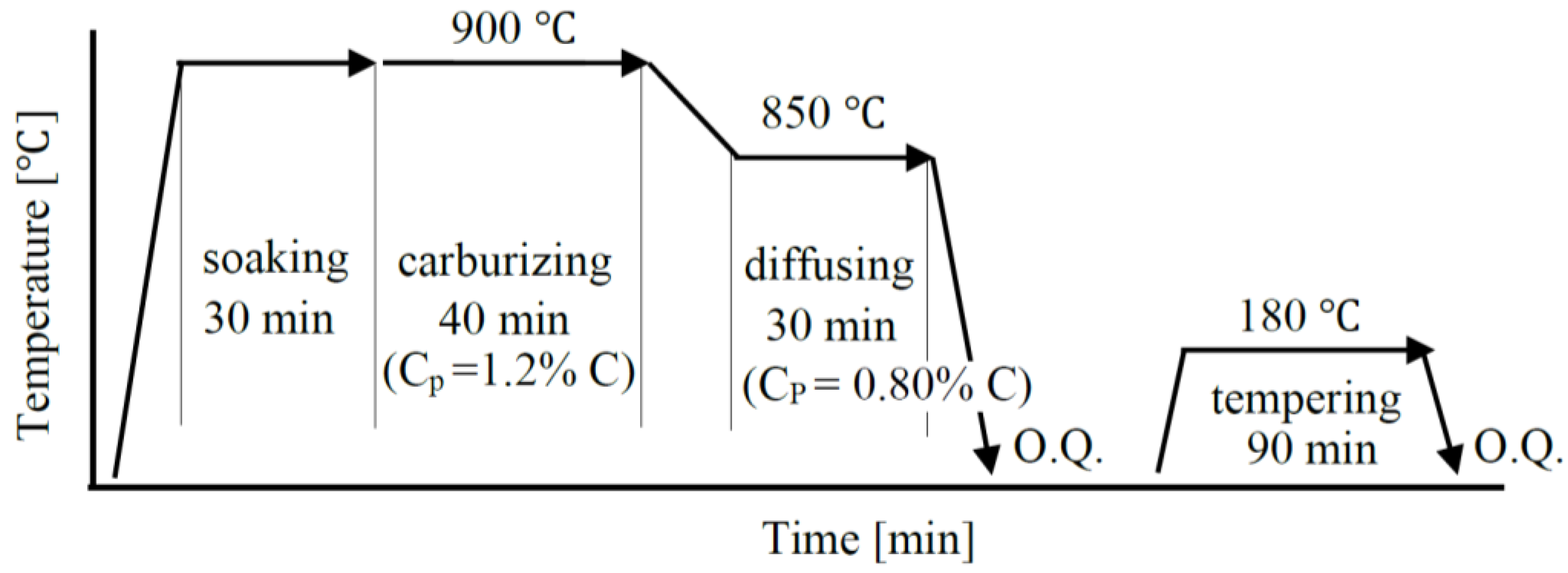
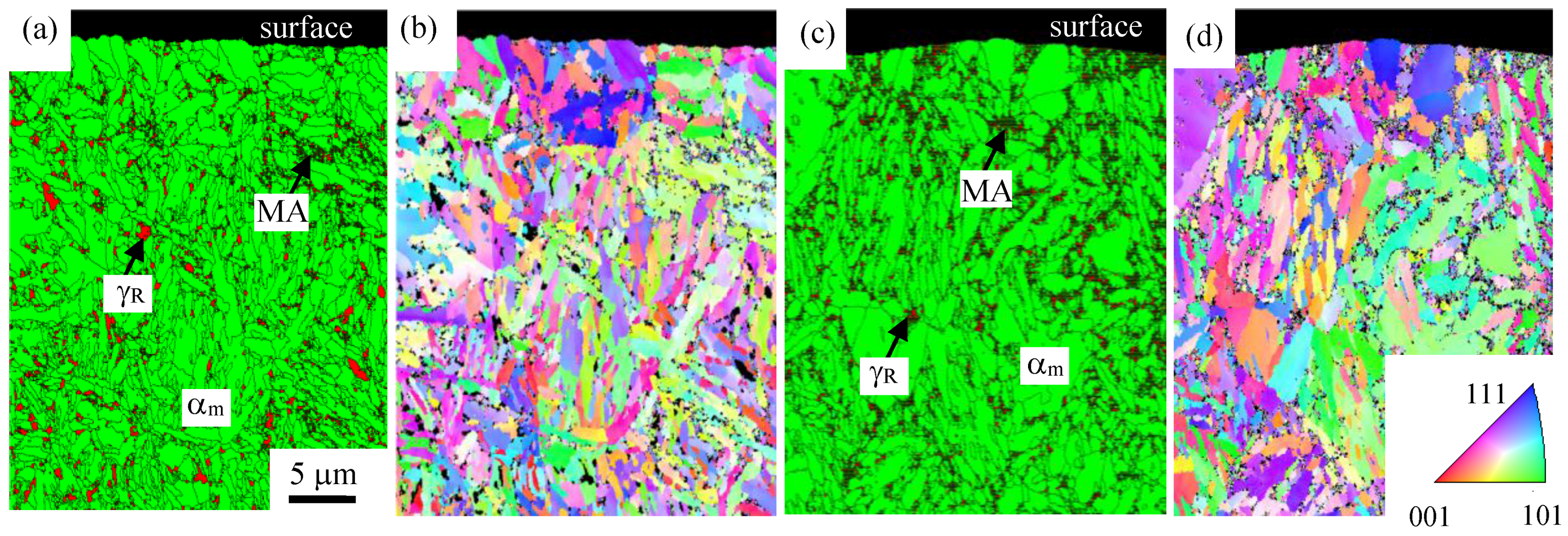
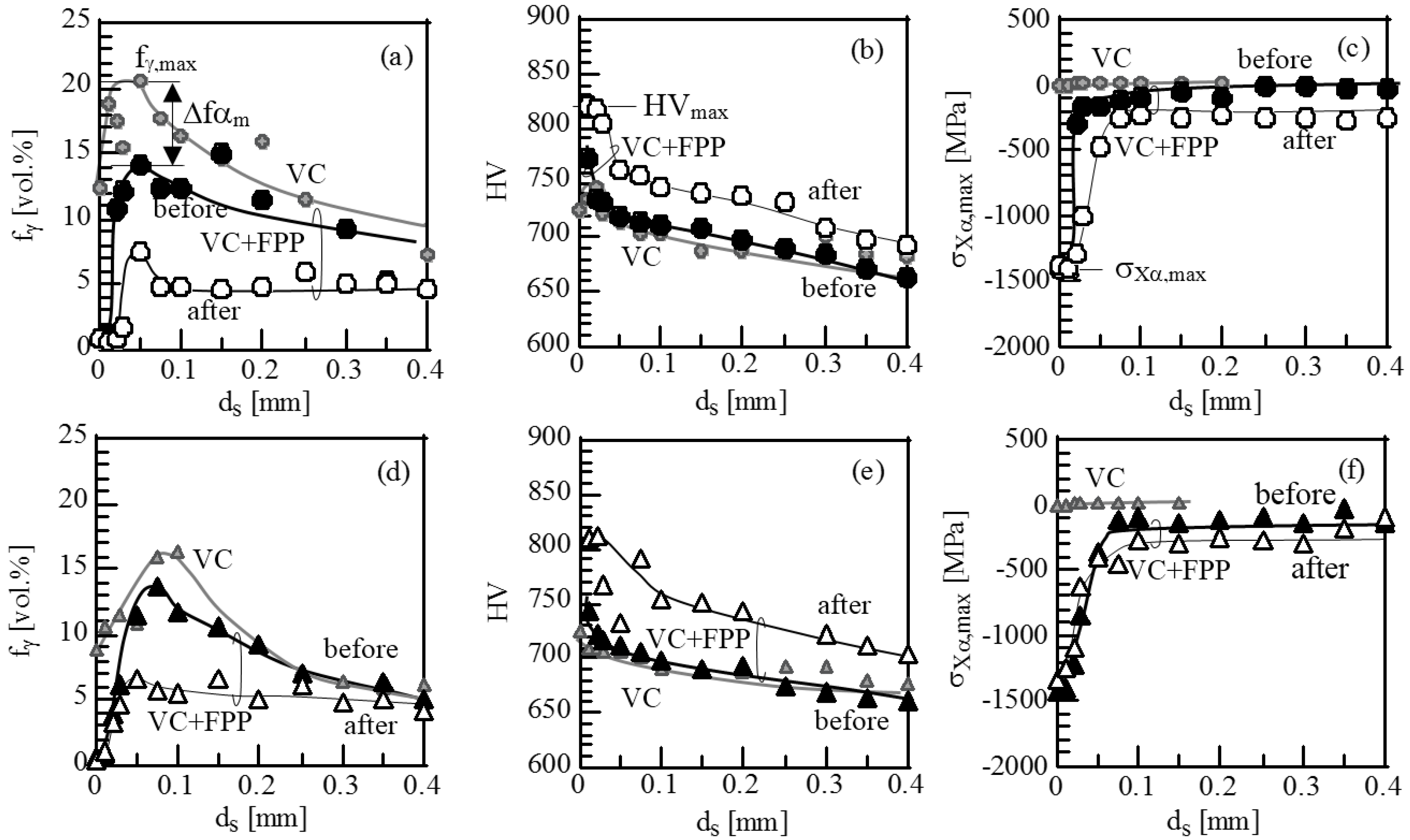
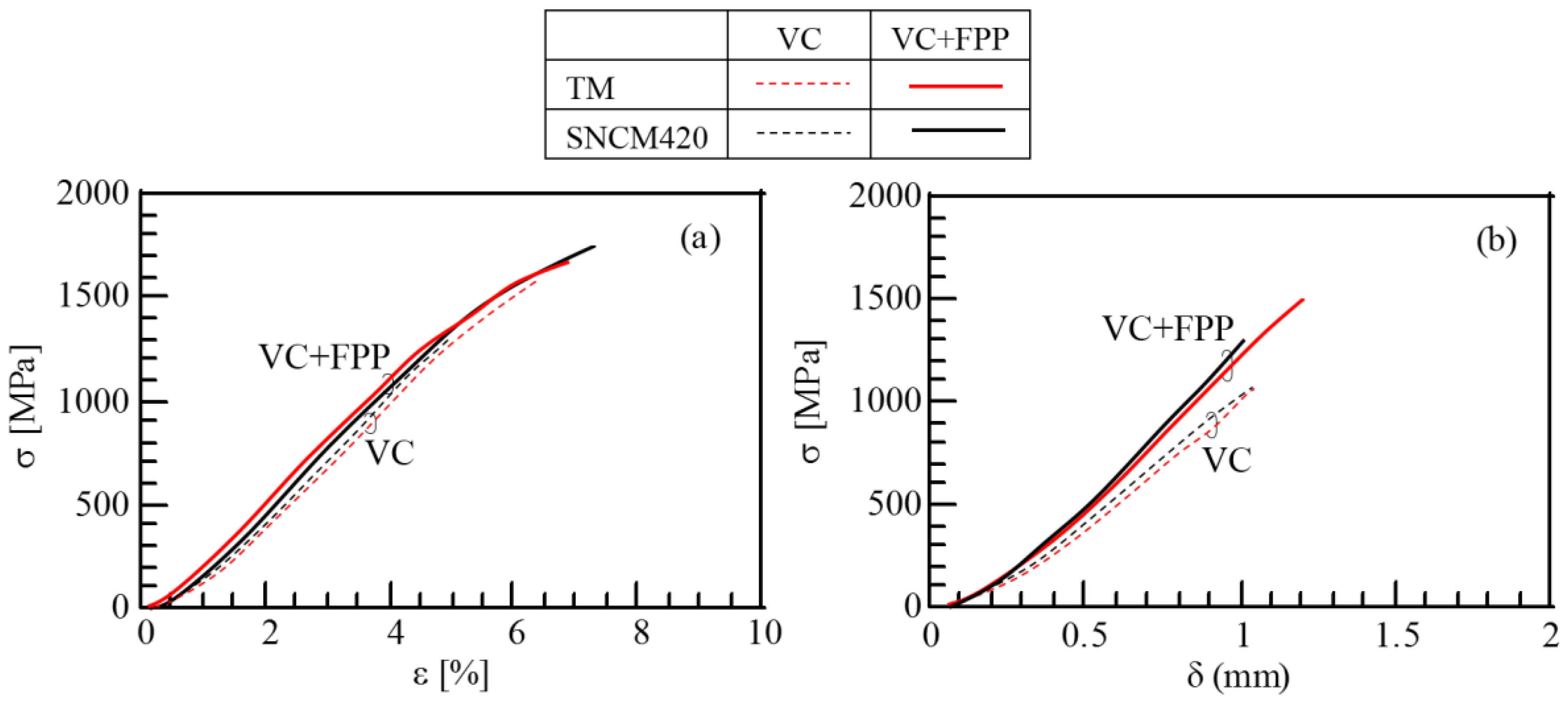
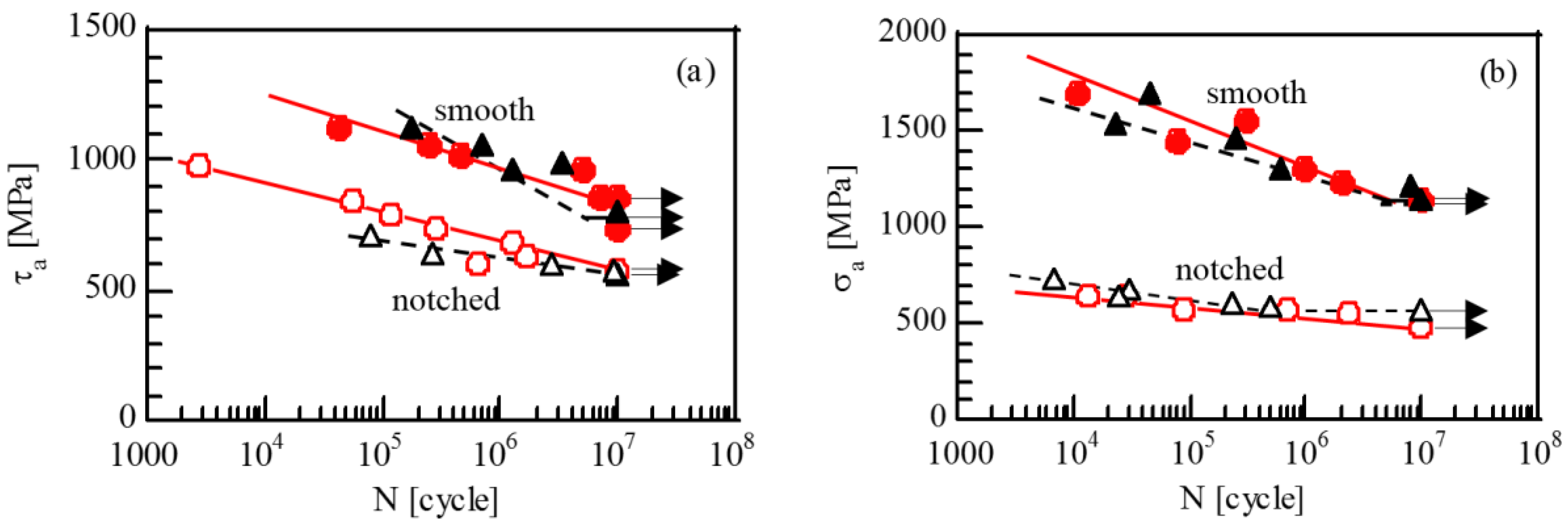

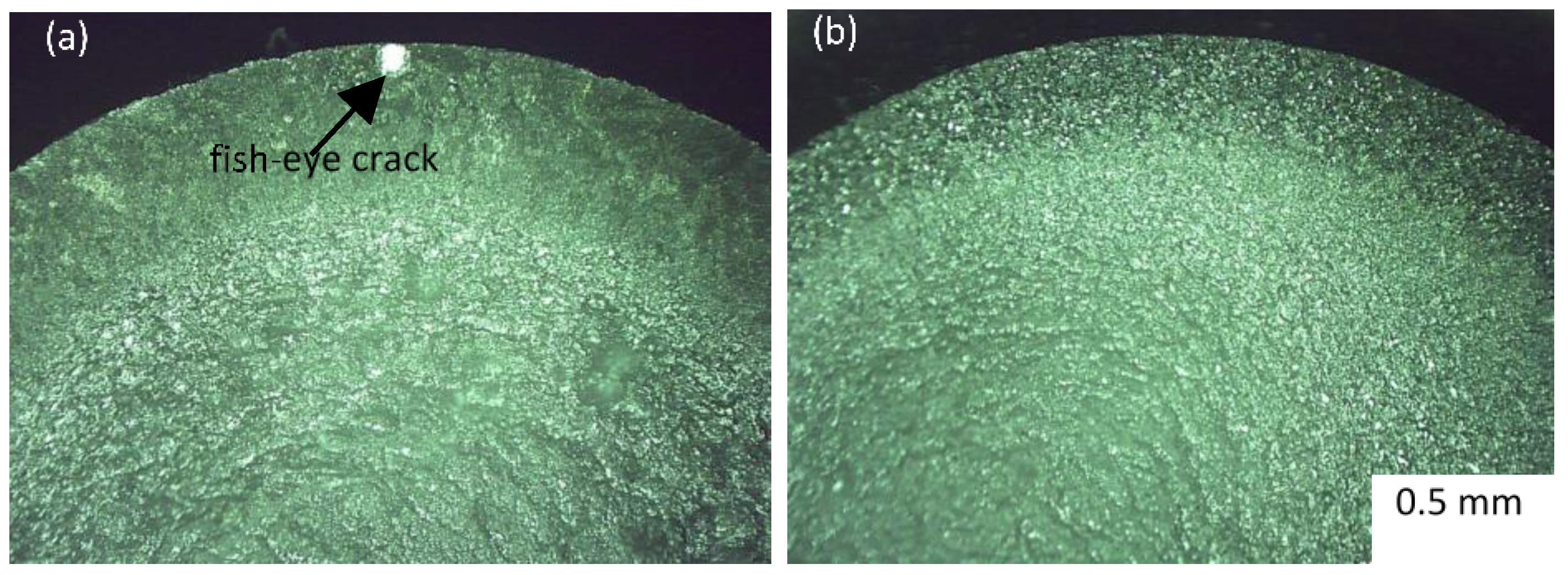


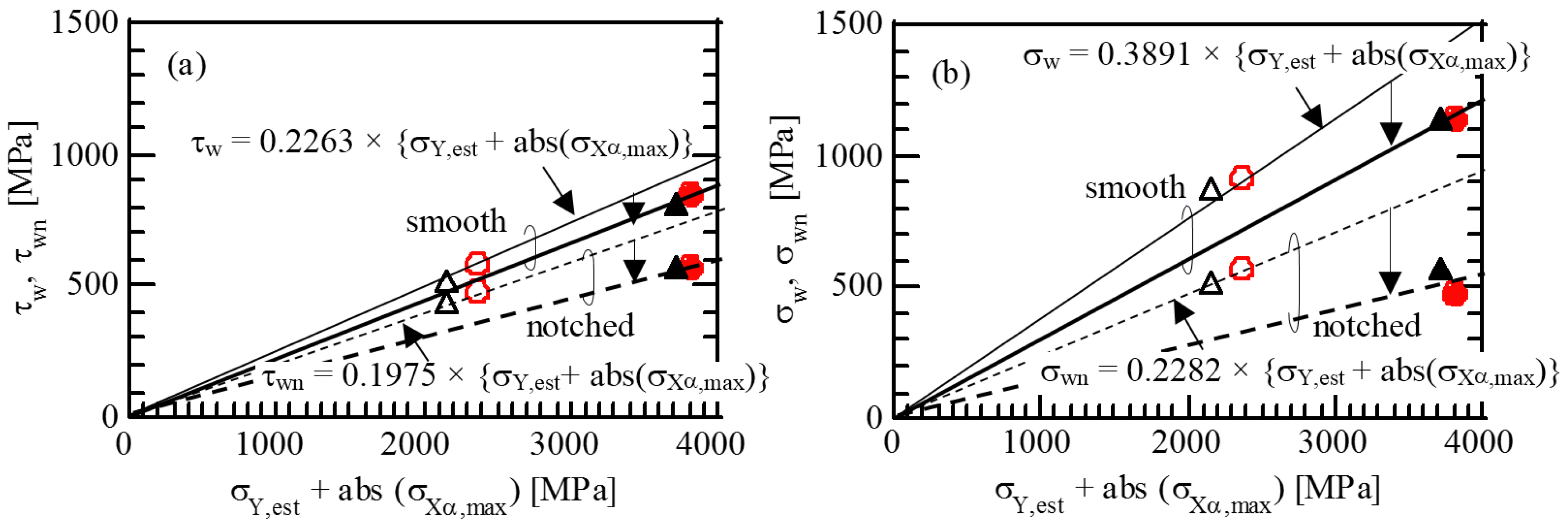

| Steel | C | Si | Mn | P | S | Cr | Mo | Ni | Nb | Al | N |
|---|---|---|---|---|---|---|---|---|---|---|---|
| TM | 0.20 | 1.50 | 1.51 | 0.005 | 0.002 | 1.00 | 0.01 | 0.02 | 0.05 | 0.039 | 0.0009 |
| SNCM420 | 0.20 | 0.20 | 0.50 | 0.009 | 0.013 | 0.55 | 0.15 | 1.68 | 0.00 | - | - |
| Shot Material | Steel |
|---|---|
| Shot Vicker Hardness | 697–832 |
| Shot Diameter [µm] | 70 |
| Pressure [MPa] | 0.26 |
| Pressure Mode | Air Nozzle |
| Arc Height [mm (N)] | 0.104 |
| Coverage [%] | 300 |
| Steel | Condition | RZ | fγ,max | HVmax | σXα,max | TS | TSN | NSR | El | RA |
|---|---|---|---|---|---|---|---|---|---|---|
| TM | VC | 3.0 | 20.5 | 745 | −97 | 1576 | 1038 | 0.66 | 0.50 | 3.0 |
| VC + FPP | 3.9 | 16.5 | 772 | −1425 | 1669 | 1509 | 0.90 | 0.87 | 1.6 | |
| SNCM 420 | VC | 3.3 | 16.3 | 725 | −123 | 1295 | 1076 | 0.83 | 0.12 | 1.8 |
| VC + FPP | 3.9 | 13.5 | 743 | −1414 | 1745 | 1297 | 0.74 | 1.30 | 1.9 |
| (a) | Specimen | Smooth | Notched | ||||||
| τa | Nf | τa | Nf | ||||||
| TM | 736 | 1.00 × 107 | 572 | 1.00 × 107 | |||||
| 855 | 1.00 × 107 | 600 | 6.59 × 105 | ||||||
| 855 | 7.18 × 106 | 637 | 1.67 × 106 | ||||||
| 962 | 4.94 × 106 | 678 | 1.27 × 106 | ||||||
| 1022 | 4.56 × 105 | 744 | 2.77 × 105 | ||||||
| 1064 | 2.50 × 105 | 786 | 1.20 × 105 | ||||||
| 1129 | 4.21 × 104 | 842 | 5.41 × 104 | ||||||
| 976 | 2.80 × 103 | ||||||||
| SNCM420 | 807 | 1.00 × 107 | 565 | 1.00 × 107 | |||||
| 962 | 1.27 × 106 | 573 | 9.26 × 106 | ||||||
| 986 | 3.30 × 106 | 600 | 2.75 × 106 | ||||||
| 1063 | 6.83 × 105 | 637 | 2.60 × 105 | ||||||
| 1123 | 1.76 × 105 | 714 | 8.02 × 104 | ||||||
| (b) | Specimen | Smooth | Notched | ||||||
| σa | Nf | σa | Nf | ||||||
| TM | 1143 | 1.00 × 107 | 485 | 1.00 × 107 | |||||
| 1225 | 2.13 × 106 | 556 | 2.41 × 106 | ||||||
| 1307 | 9.87 × 105 | 565 | 1.26 × 106 | ||||||
| 1455 | 8.05 × 104 | 571 | 6.71 × 105 | ||||||
| 1547 | 3.09 × 105 | 648 | 1.35 × 104 | ||||||
| 1700 | 1.10 × 104 | 651 | 2.89 × 104 | ||||||
| SNCM420 | 1139 | 1.00 × 107 | 570 | 1.00 × 107 | |||||
| 1219 | 8.31 × 106 | 591 | 4.80 × 105 | ||||||
| 1298 | 6.06 × 105 | 608 | 2.27 × 105 | ||||||
| 1466 | 2.43 × 105 | 652 | 2.46 × 104 | ||||||
| 1539 | 2.31 × 104 | 674 | 3.11 × 104 | ||||||
| 1700 | 4.67 × 103 | 732 | 6.57 × 103 | ||||||
| Steel | Process | τw | τwn | qt | σw | σwn | qb |
|---|---|---|---|---|---|---|---|
| TM | HT | 404 | 364 | 0.18 | 675 | 381 | 0.86 |
| HT+FPP | 582 | 481 | 0.35 | 919 | 572 | 0.67 | |
| VC | 654 | 498 | 0.52 | 703 | 320 | 1.32 | |
| VC+FPP | 855 | 572 | 0.82 | 1143 | 485 | 1.51 | |
| SNCM 420 | HT | 366 | 358 | 0.03 | 586 | 378 | 0.61 |
| HT+FPP | 518 | 434 | 0.32 | 872 | 521 | 0.75 | |
| VC | 628 | 461 | 0.60 | 803 | 481 | 0.74 | |
| VC+FPP | 807 | 565 | 0.71 | 1139 | 570 | 1.11 |
© 2017 by the authors. Licensee MDPI, Basel, Switzerland. This article is an open access article distributed under the terms and conditions of the Creative Commons Attribution (CC BY) license (http://creativecommons.org/licenses/by/4.0/).
Share and Cite
Sugimoto, K.-i.; Hojo, T.; Mizuno, Y. Torsional Fatigue Strength of Newly Developed Case Hardening TRIP-Aided Steel. Metals 2017, 7, 375. https://doi.org/10.3390/met7090375
Sugimoto K-i, Hojo T, Mizuno Y. Torsional Fatigue Strength of Newly Developed Case Hardening TRIP-Aided Steel. Metals. 2017; 7(9):375. https://doi.org/10.3390/met7090375
Chicago/Turabian StyleSugimoto, Koh-ichi, Tomohiko Hojo, and Yuta Mizuno. 2017. "Torsional Fatigue Strength of Newly Developed Case Hardening TRIP-Aided Steel" Metals 7, no. 9: 375. https://doi.org/10.3390/met7090375





